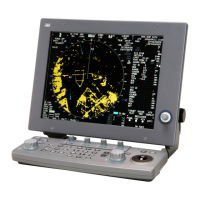[IV] False Echo by Multiple Reflection
When there is a large structure or ship with a high vertical surface near own ship as shown in Figure 6.5,
multiple refection returns may appear on the radar display. These echoes appear in the same intervals, of
which the nearest echo is the true echo of the target.
Figure 6.5
[V] Abnormal Propagation
The maximum radar detection range depends upon the height of the scanner and the height of a target as
described in the section of “The Horizon for Radar Beam Radiation”. If a so-called “duct” occurs on the
sea surface due to a certain weather condition, however, the radar beam may propagate to a abnormally
long distance, at which a target may be detected by the radar.
For instance, assuming that the radar range is 6 NM (on the repetition frequency of 1100 Hz), the first
pulse is reflected from a target at about 76 NM or more and received during the next pulse repetition time.
In this case, a false echo appears at a position that is about 76 NM shorter than the actual distance.
If the false echo appears at 5 NM on the radar display, the true distance of the target is 5+76=81 NM. On
the radar range scale of 1.5 NM (on the repetition frequency of 1900 Hz), a false echo may appear at a
position that is about 43 NM shorter than the actual distance.
This type of false echo can be discriminated by changing over the range scale (the repetition frequency),
because the distance of the target changes accordingly.
6─7

